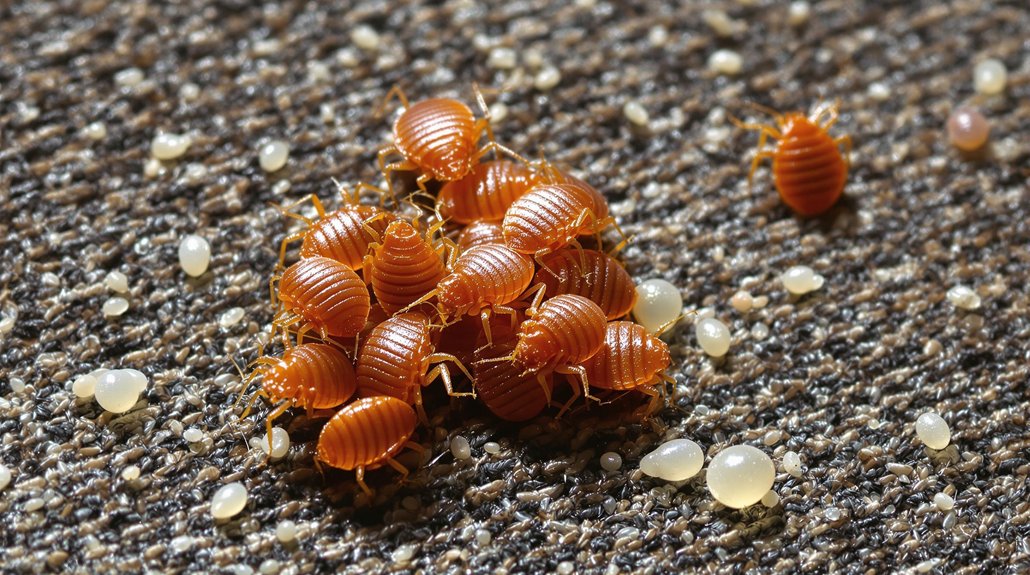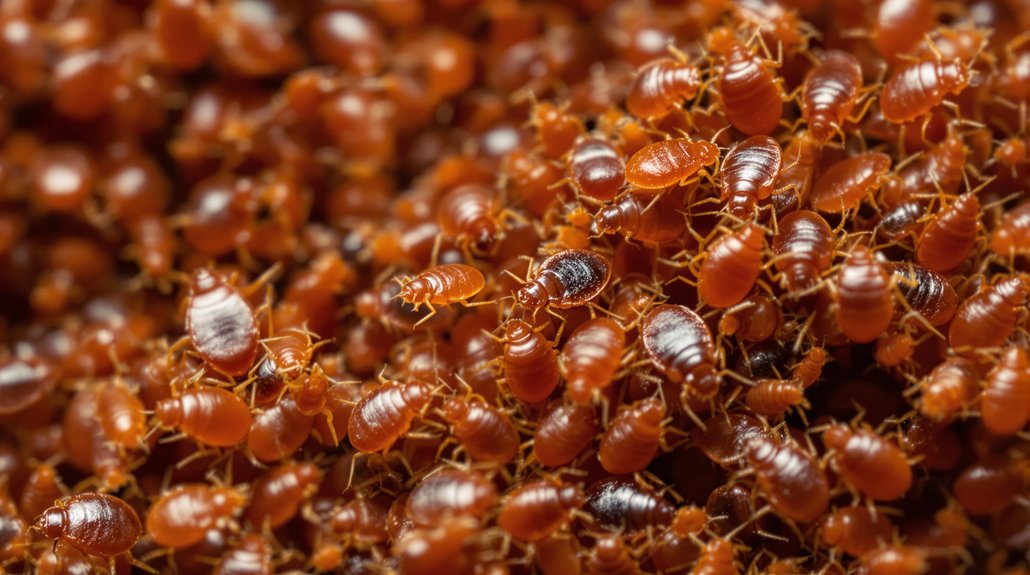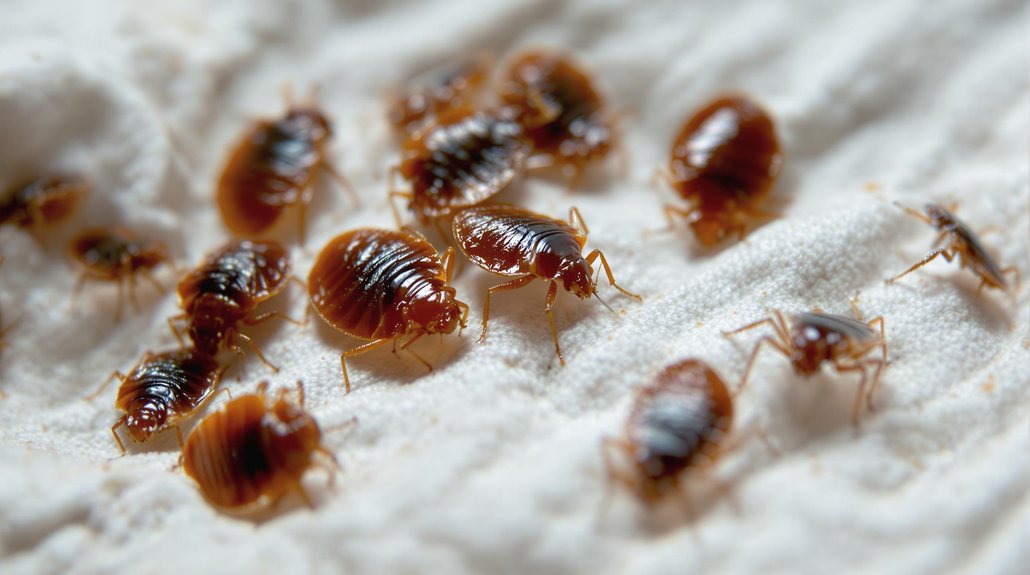
Bed bugs do not multiply when they are killed. They reproduce only when they are alive, healthy, and able to mate. If a bed bug is killed, it cannot lay eggs or cause more bugs. To control an infestation, all bugs must be eliminated. Killing a few bugs won’t stop the problem. Understanding how bed bugs reproduce and respond to threats can help in managing them more effectively. Keep exploring to learn more about effective control strategies.
Key Article Highlights
- Killing bed bugs alone does not increase their population; their multiplication relies on reproduction, not death.
- Females can lay eggs without males, but the eggs won’t hatch if the bed bugs are killed before breeding.
- Proper treatment methods target both bugs and eggs to prevent further reproduction and infestation.
- Incomplete or ineffective removal may leave eggs hatchlings, giving the false impression that bugs multiply after being killed.
- Integrated pest management ensures thorough elimination, stopping reproduction and preventing population growth.
Understanding Bed Bug Reproduction

Bed bugs reproduce through a process called copulation, where male bed bugs transfer sperm to females. This process is part of their mating behaviors. After copulation, females enter their reproductive cycles. During these cycles, females can lay multiple eggs. The eggs hatch into nymphs, which grow into adult bed bugs. The reproductive cycles are continuous if conditions are right. Bed bugs do not require a male to lay eggs, but fertilization is necessary for producing viable eggs. Mating behaviors involve males approaching females and depositing sperm through a process called traumatic insemination. Understanding these behaviors and cycles helps explain how quickly bed bugs can multiply. Proper knowledge of reproductive cycles is essential for controlling infestations effectively.
The Lifecycle of a Bed Bug
The life of a bed bug has different stages. It starts as an egg and then becomes a nymph before turning into an adult. This process includes reproduction and egg laying, which help the population grow. Regular inspection and preventive measures can help control their spread.
Bed Bug Development Stages
Understanding the development stages of bed bugs is important for effective control. Bed bugs go through three main stages: eggs, nymphs, and adults. Their development depends on their anatomy and behavior. Eggs are tiny and sticky, making them easy to hide. Nymphs are small, translucent, and go through five molts before reaching adulthood. Each stage requires a blood meal to grow. Adults are larger, with fully developed features and the ability to reproduce. Bed bug behavior drives their development; they hide during the day and feed at night. Knowing these stages helps in identifying and targeting infestations. Controlling each stage reduces the chance of the bugs multiplying. This knowledge is key for successful treatment efforts.
Reproduction and Egg Laying
Reproduction plays a key role in bed bug growth. Bed bugs reproduce through bed bug mating, which involves the male and female insects. During mating, the male inserts sperm into the female’s body. After mating, the female begins egg production. A female bed bug can lay eggs almost daily if conditions are right. She lays her eggs in hidden places, like mattresses, furniture, or cracks. Each female can produce hundreds of eggs in her lifetime. The eggs are tiny, white, and oval-shaped. They hatch in about one to two weeks. After hatching, young bed bugs, called nymphs, go through several growth stages. Proper understanding of reproduction and egg laying helps in controlling bed bug infestations.
How Bed Bugs Respond to Threats

Bed bugs often hide when they sense danger. They have specific threat responses that help them survive. When they feel threatened, they try to stay hidden and avoid damage. These survival strategies make it hard to eliminate them quickly. Bed bugs may scatter into cracks or crevices and stop moving to avoid detection. Sometimes, they react aggressively and bite humans if cornered. Their quick hide response reduces the chance of death from treatment. Understanding these responses can help in planning effective control methods. It is important to act carefully, as disrupting their hiding spots may cause them to spread. Overall, threat responses are part of the bed bugs’ natural survival strategies, making them difficult to eliminate. Proper knowledge can improve pest management efforts.
Common Myths About Killing Bed Bugs
Many people believe there are simple ways to kill bed bugs quickly, but these ideas are often myths. Myth debunking shows that common misconceptions can lead to ineffective treatment. For example, some think that smashing bed bugs alone will eliminate an infestation. This is not true because eggs are hard to reach and can survive attempts to kill bugs. Others believe that heat or cold can instantly solve the problem. While these methods help, they must be used correctly and thoroughly. Sprays and chemicals may also be thought of as quick fixes, but they often require multiple applications. Understanding these common misconceptions is important for effective treatment. The truth is that killing bed bugs takes careful planning, time, and persistence.
The Role of Stress in Bed Bug Behavior

Stress can cause bed bugs to change their behavior. When stressed, they may reproduce more quickly. Stress also makes them feed differently and become more aggressive.
Stress Triggers Reproductive Surge
Research suggests that stress can increase the reproductive activity of bed bugs. When a bed bug experiences stress, it triggers a stress response that can boost its reproductive capacity. Stress signals may come from environmental changes or attempts to control infestations. In turn, this stress response may cause bed bugs to reproduce more rapidly. This increase in reproductive activity can make control efforts harder.
- Bed bugs under stress may lay more eggs quickly
- Stress can lead to more frequent mating behaviors
- Stress responses may cause bed bugs to seek safer hiding spots
Understanding this link helps explain why infestations sometimes grow despite interventions. Managing stress factors can be an important part of controlling bed bug populations effectively.
Disruption Alters Feeding Habits
Disruptions in the environment can change how bed bugs feed. Stress from disturbances affects their feeding patterns. When their environment is disturbed, bed bugs may feed more often or less frequently. These disruption effects make them change their usual behavior. Some bed bugs may become aggressive and seek blood more often. Others may hide and delay feeding. This change depends on the level of stress they face. Understanding this helps control them better. The table below shows common disruption effects and their influence on feeding habits:
| Disruption Effects | Feeding Pattern Changes |
|---|---|
| Noise and movement | Increased feeding or avoidance |
| Temperature shifts | Altered feeding times |
| Vacant or disturbed hideouts | Unpredictable feeding intervals |
Killing Edges Bed Bug Aggression
Killing edges, such as sharp tools or edges used to remove bed bugs, can influence their behavior. When bed bugs are exposed to killing methods, it often increases their aggression. Stress from being harmed makes them act more defensively. This heightened aggression can lead to more biting and moving around. Bed bugs might try to hide or escape more quickly after being disturbed. Some studies suggest that aggressive behavior grows when they are repeatedly harmed. People should be aware that certain killing edges might make bed bugs more aggressive instead of stopping them. Choosing the right bed bug killing method can help manage their behavior. Effective methods reduce stress and prevent them from becoming more hostile. Proper removal tools and techniques are essential in controlling bed bug aggression.
Effective Methods for Bed Bug Control
Effective methods for controlling bed bugs include various approaches that aim to reduce their numbers and eliminate infestations. These methods often combine techniques like integrated pest management, chemical treatments, and heat treatments. Mattress encasements help block bed bugs in beds. Vacuuming techniques remove bugs and eggs from surfaces. Professional extermination offers thorough solutions, while DIY solutions can address smaller problems. Preventive measures, such as reducing clutter and sealing cracks, stop bugs from spreading. Using these methods together increases the chance of success. It is important to be consistent and persistent. Bed bug control requires patience and care. Below is a table showing different control methods and their effects:
| Method | Effect |
|---|---|
| Chemical treatments | Quickly kills bugs and eggs |
| Heat treatments | Penetrates hiding spots and kills all |
| Mattress encasements | Prevents bugs from biting and hiding |
| Vacuuming techniques | Removes bugs, eggs, and shed skins |
| Professional extermination | Provides expert, complete removal |
Mistakes That Can Worsen Infestations
Mistakes in bed bug control can make infestations worse. Many people unknowingly create problems by making common mistakes. Using ineffective treatments is a big mistake. Some spray products only kill adult bed bugs and leave eggs behind, which leads to more bugs later. Another mistake is not treating all affected areas at once. Focusing on one spot can cause ongoing infestation. Additionally, moving infected furniture or bedding without proper cleaning spreads bed bugs to new places. These mistakes can make the problem worse instead of solving it. It is important to understand that incorrect or incomplete methods do not work well. Controlling bed bugs requires careful planning and the right approach to break their lifecycle. Avoiding these common mistakes helps manage and eliminate infestations more effectively.
Tips for Sustainable Bed Bug Management
To manage bed bugs over the long term, it is important to use methods that are sustainable. Eco friendly solutions and preventive measures help reduce reliance on harsh chemicals. Natural repellents can discourage bed bugs from settling in certain areas. Chemical alternatives may be used carefully under professional guidance. Monitoring techniques, such as traps and inspections, help detect infestations early. Habitat inspection is essential to find hiding spots and eliminate clutter where bugs may hide. Integrated pest management combines various methods for effective control. Regular professional treatments can keep bed bugs under control without overwhelming the environment. These sustainable practices focus on safety and effectiveness, helping homeowners control bed bugs while protecting the environment.

